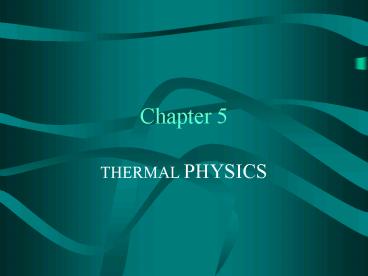THERMAL PHYSICS PowerPoint PPT Presentation
1 / 10
Title: THERMAL PHYSICS
1
Chapter 5
- THERMAL PHYSICS
2
temperature a measure of the warmth or coldness
of an object A change
in size with a change in temperature is
a property of all materials regardless of
physical state. This property is the basis for
the construction of the
thermometer.
3
Temperature Scales
In the U.S. the most commonly used
temperature scale is the Fahrenheit. (Gabriel
Fahrenheit 1686-1736) f.p. 32 F
b.p. 212 F The Celsius scale is
more compatible with the spirit of the metric
system. (Anders Celsius 1701-1744) f.p.
0 C b.p. 100 C The SI
scale used to measure temperature is the Kelvin
scale. (William Thomson, Lord Kelvin 1824-1907)
f.p. 273 K b.p.
373 K Zero kelvins is known as absolute zero.
4
Conversions BetweenTemperature Scales
F 1.8(C) 32 C (F 32)
1.8 K C 273 C K 273
5
heat The energy that is transferred from one
system to another when two systems at different
temperatures are in contact. Units
Used to Measure Heat calorie (cal) The amount
of heat necessary to raise the temperature of 1 g
of water by 1 C. The large Calorie (Cal) is the
energy unit for foods. 1 Cal 1000 cal British
thermal unit (Btu) The amount of heat required
to raise the temperature of 1 lb. of water by 1
F.
6
The SI unit of energy is the joule. (James Joule
1818-1889) As a result of his observations and
experiments, Joule realized that the changes
produced by heating a substance could also be
produced by mechanical energy.
1 cal 4.186 J thermal energy The
combined energy of motion of all the particles in
a sample. temperature a measure of the average
kinetic energy of the atoms or molecules of a
substance a measure of the warmth or coldness of
an object
7
specific heat The quantity of energy required to
raise the temperature of 1 g of a substance by
1C. Specific heat is a physical property of a
substance. The specific heat is unique to a
particular substance and a substance has a
different specific heat in its different
phases. Q
mc?T Q heat measurement c specific heat m
mass ?T change in temp.
8
Heat and Changes of Phase
A change of phase refers to a change in the
physical state of a substance (solid, liquid,
gas). heat of fusion heat necessary to convert
a given amount of a solid into a liquid heat of
vaporization amount of heat necessary to convert
a given amount of liquid into a gas The values
of these depend on the substance. (Table 5.2 pg.
105)
9
Heat Transfer
1. conduction The process by which thermal
energy is transmitted directly through materials.
Energetic atoms move rapidly and collide with
neighboring atoms. Kinetic energy is transferred
during the collision process. conductors
materials that allow heat to travel through them
easily insulators materials that inhibit the
flow of heat
10
2. convection The process by which thermal
energy is transmitted through gases and liquids
by the action of currents that circulate in the
fluid. 3. radiation The process by which energy
is emitted and transmitted as electromagnetic
waves. Infrared radiation is also known as
radiant heat. All warm objects emit infrared
radiation. Every object that is at a temperature
other than absolute zero emits infrared
radiation, and the hotter the object, the more
radiation it emits.

